

Of the keyboard, just where they would be most easy to use. The main visible difference is the siting of the control levers at the front

Weber design, which still looks remarkably like the Aeriol Piano from 1897. Consequently it introduced the new Pianola Piano in 1904, based on a substantial Where it could manufacture both Pianolas and first-rate pianos, all within its own organisation. The name of Weber was very well respected, and Aeolian suddenly found itself in a position Price, in view of an imminent mortgage on the large Weber factory in lower Manhattan. In August 1903, the Weber Piano Company was purchased by the Aeolian Company, which at the same time reconstituted itself as the Aeolian, Weber Piano and PianolaĬompany, taking its names from the three main areas of its subsequent business, the Aeolian, the Weber Piano, and the Pianola. Theodore Brown applied to patent a very similar player piano mechanism in April 1896, and it is clear that dynamic control was somewhat rudimentary. The various control levers, however, are positioned under the keyboard, implying that they cannot have beenĮasy to use in any sensitive way. Whereas the 1895 Angelus grand piano, seen on our Piano Players page, has the roll under the keyboard, the Aeriol Piano placed it in the normal position for an upright,īehind a small sliding door in the central panel above the fall. The Aeriol Piano - Aeolian Company Advertisement, New York, 1901.

The Wilcox and White player was called the Angelus, whileĪeolian marketed the Aeriol Piano (later called the Aeriola), which was designed and built by Theodore P. White and the Aeolian Company sold a few. Standard built-in player pianos can be traced back to the late 1890s, and both Wilcox and The 1880s, but these were not what we would think of today as normal player pianos. Pain, who seems to have been a one-man Aeolian Company Experimental Department in the late nineteenth century, built a few electrical interior players, even as early as New pianos for the simple purpose of playing music rolls. They were not initially available in the best known makes of piano, and because most music lovers already had their own instruments, and did not want to buy completely Mentioned on our Piano Players page, the complete instruments were actually the first to be built and sold, but they failed to take the markets by storm, because ItĪlso means that everything remains more reliably in adjustment, and that the pianolist sits at the same instrument from which the audible music issues forth. This applies equally to grands and to uprights, and it saves the inconvenience of having two separate pieces of furniture for the one purpose. Whereas a Piano Player sits in front of a normal piano, and plays it by means of a set of felt-covered fingers, a Player Piano has all the mechanisms built Party Time at the Player Piano - Pianauto Music Roll Leader, Brazil, c.1920.


 0 kommentar(er)
0 kommentar(er)
